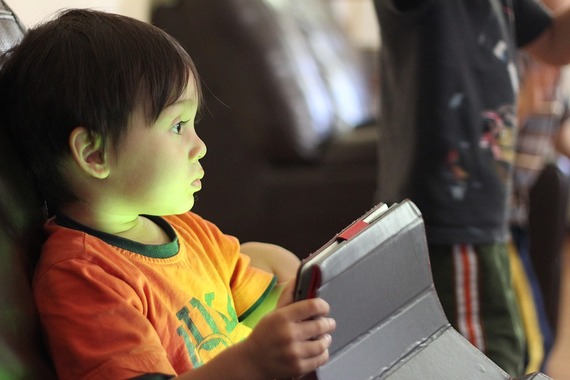To me, primary school is memorizing times tables, Ms. White (Yes, I actually had a teacher that was named that) in the front of the classroom with a ruler in her hand, painstakingly writing and rewriting cursive letters, and standing up to read passages aloud. That was 1989.
Today, primary school is using mobile apps to learn times tables, Ms. White (different White) standing in the back as students video conference with a zoologist in South America, writing and sharing digital stories on classroom blogs, and using speech recognition tools to help students read aloud. This is 2016.
Clearly, technology has touched and transformed the way teachers teach and students learn. Let's take a deeper look into how tech is the classroom
Classroom Blogging
In the UK, according to the
, writing is the worst performing core subject among Key Stages 1 and 2. In addition, studies conducted by the Department discovered that pupils enjoy writing for family and friends more than for school. This is paramount -- meaning, if teachers and schools can encourage and inspire children to enjoy writing for school just like they enjoy writing for family and friends, writing levels would undoubtedly increase.
So, how to combine the two? The quick answer, of course, is technology. Today, teachers are more than ever, setting up classroom blogs in order to provide their pupils with "authentic audiences." This way, children can write for school and for family and friends -- increasing pupils' motivation to practice their writing.
If, studies show, students write for an audience, not only do their confidence and writing abilities increase, but their peer-assessment, analytical, and observation skills develop as well. Pobble, for example, is one such UK-based startup capitalizing on these revealing studies. Pobble is a platform in which teachers can upload students' writing -- enabling parents, teachers, and other students from around the world to comment, like, and share their work. The team, which includes a number of primary school teachers, understands that writing for an audience empowers pupils to take ownership of their writing, while inspiring them to write well.
E-reading Technology
If you think back, you'll remember Round Robin Reading, a classroom activity in which pupils read an assigned text out loud, one after the other. And, if you were a poor reader, you'll remember your heart pounding through your chest as you try to figure out which passage you'd have to read aloud. RRR has, for this reason, been
-- it discourages and stigmatizes children already hesitant about their reading skills, weakens comprehension, and hurts fluency and pronunciation.
This, of course, is where technology comes in. Today, there are dozens of apps and programs designed to encourage reading fluency among pupils. Teachers can present children with high-quality multimedia digital books that read text aloud expressively while it simultaneously highlights the words on a computer screen or tablet.
Put plainly, adding multimedia and additional materials such as sound bites, images, and videos into digital text on tablets not only improves children's focus and recognition, but also helps struggling readers by providing immediate individualized feedback and additional practice opportunities. In addition, teachers can encourage reading by getting children to read and review other children's writing on their tablets, stories that are linked to the topics they're currently learning in class.
Game-Based Learning
Sure, I grew up on Tetris -- but I didn't grow up with computers and gaming consoles the way children today do. It's everywhere, and provides a great opportunity for teachers to use gaming platforms to spark students' interests in reading and writing. In particularly, digital games are growing popular in classrooms because in addition to being highly engaging, they're also suitable for curriculum content, core skills, language acquisition, problem-solving and pupil collaboration.
Similar to e-reading technologies, game-based learning applications provide children with immediate feedback, informing the pupils whether their choice was correct or incorrect. There are several studies that suggest children playing reading games in school make more gains in reading and spelling than children learning from traditional reading materials. In specific, such apps can improve reading speed of syllables, phoneme awareness skills, and attention.
Yes, there are apps and games directed specifically at teaching reading, writing, and spelling, but even video games like Elegy for a Dead World can be used as an immersive learning system to get pupils excited about the material -- wrapping them in a story with memorable characters and narrative fiction. Elegy is a video game in which children explore post-apocalyptic worlds, and after each level, they're prompted to write about their encounters and adventures. It's meant to spark their imaginations and get them excited about writing. If children care about the task, they will enjoy reading, responding, and critiquing the stories within the game. Ultimately, motivation is key.
Support HuffPost
Our 2024 Coverage Needs You
Your Loyalty Means The World To Us
At HuffPost, we believe that everyone needs high-quality journalism, but we understand that not everyone can afford to pay for expensive news subscriptions. That is why we are committed to providing deeply reported, carefully fact-checked news that is freely accessible to everyone.
Whether you come to HuffPost for updates on the 2024 presidential race, hard-hitting investigations into critical issues facing our country today, or trending stories that make you laugh, we appreciate you. The truth is, news costs money to produce, and we are proud that we have never put our stories behind an expensive paywall.
Would you join us to help keep our stories free for all? Your contribution of as little as $2 will go a long way.
Can't afford to donate? Support HuffPost by creating a free account and log in while you read.
As Americans head to the polls in 2024, the very future of our country is at stake. At HuffPost, we believe that a free press is critical to creating well-informed voters. That's why our journalism is free for everyone, even though other newsrooms retreat behind expensive paywalls.
Our journalists will continue to cover the twists and turns during this historic presidential election. With your help, we'll bring you hard-hitting investigations, well-researched analysis and timely takes you can't find elsewhere. Reporting in this current political climate is a responsibility we do not take lightly, and we thank you for your support.
Contribute as little as $2 to keep our news free for all.
Can't afford to donate? Support HuffPost by creating a free account and log in while you read.
Dear HuffPost Reader
Thank you for your past contribution to HuffPost. We are sincerely grateful for readers like you who help us ensure that we can keep our journalism free for everyone.
The stakes are high this year, and our 2024 coverage could use continued support. Would you consider becoming a regular HuffPost contributor?
Dear HuffPost Reader
Thank you for your past contribution to HuffPost. We are sincerely grateful for readers like you who help us ensure that we can keep our journalism free for everyone.
The stakes are high this year, and our 2024 coverage could use continued support. If circumstances have changed since you last contributed, we hope you’ll consider contributing to HuffPost once more.
Already contributed? Log in to hide these messages.

